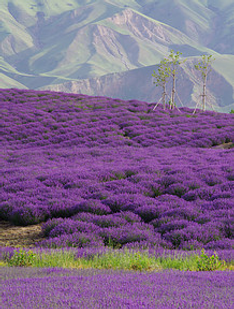
Lavender has been around for 2500 years. It is in the mint family and is known for its beauty, sweet smelling aroma, and its multiple uses. The Egyptians used lavender for mummification and perfume. In the Middle Ages it was used by Catholics in stews to ward off evil spirits. The ancient Romans used lavender for its antiseptic and healing qualities. Today, we still use lavender in some of the same ways our ancient counterparts did, but we have learned a great deal more about the wonders of lavender. Read all about some common uses of lavender.
If you would like to read how to care for lavender, click here.
(Some of the links within this post are affiliate links on which I receive a small compensation from the sale of certain items)
(As an Amazon Associate I earn from qualifying purchases.)
Common Uses of Lavender
There are three varieties of lavender – English, French, and Spanish. Each variety excels in different ways.
Culinary
The English variety (Lavandula angustifolia) is mostly used in recipes. It has the sweetest fragrance which creates flavor in cooking. The flowers add a subtly sweet, citrus flavor to a recipe.
French lavender (Lavandula dentata) has a strong pine flavor which is not appealing in food. Instead it is used more for creating essential oils and for its strong scent to create soothing environments.
Spanish lavender (Lavendula stoechas) resembles French lavender in that it too has a strong pungent flavor…..not good for recipes. It is mostly used in soaps, perfumes and lotions.
So if you plan to grow lavender for culinary purposes, be sure to grow the English variety. Also, be sure it is “culinary” lavender to ensure it has not been sprayed with pesticides.
Tips on Cooking With Lavender
-Given English lavender’s very strong flavor, begin with just a little amount. You can always add more later.
-Grind the buds to mix into sugar.
-Seep and strain the buds for a liquid version similar to simple syrup or honey.
-For measuring purposes, 1 part fresh buds equals 1/3 part dried buds.
For more on lavender recipe ideas, refer to this website by Martha Stewart.
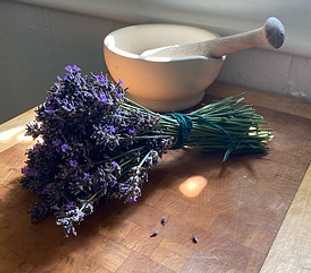
Medicinal Uses
Throughout the centuries, lavender has been used to treat common ailments. According to WebMD, lavender MAY be helpful in some of the following areas but there is no scientific proof backing this. Use at your own risk.
-
The essential oil from lavender (Etsy) soothes and relieves the soreness and redness of an episiotomy after childbirth (a vaginal cut to aide birth).
-
Using lavender oil and other essential oils may decrease hair loss from alopecia areata, an autoimmune disease that tricks the leukocytes in your blood into attacking hair follicles.
-
Dried culinary lavender sprinkled on yogurt may tame stomach aches due to inflammation of the colon commonly known as colitis.
-
Lavender roots are very hardy and tough, therefore they absorb harmful metals like lead and zinc. This can help clean up industrial sites and garden plots full of contamination.
-
It is used as a household cleaner when 8 drops of lavender oil is combined with 1/2 cup of baking soda. Sprinkle this combination onto rugs, wait a few minutes, then vacuum out all those nasty smells and bacteria.
-
Lavender scent has been shown to improve your memory recall. When nursing students were given lavender to smell right before a test, their scores were higher than others. They were more relaxed, concentrated better and were less anxious.
-
The scent of lavender can control motion sickness when paired with ginger. Its smell distracts your senses from the feeling of motion.
-
A study was performed on colicky babies aged 2 to 6 weeks. Mothers rubbed their childs’ bellies with 1 drop of lavender oil in 20 milliliters of almond oil. The babies got progressively less colicky and quieted down more quickly than those not massaged with the oil.
-
To rid someone of hair lice, use lavender oil with tea tree oil.
-
It can reduce hot flashes brought on by menopause if sniffed for 20 minutes twice a week. The study showed the women who used the aromatherapy treatment had 50% fewer flashes than the others who did not use the therapy.
-
Lavender can be used as a hand sanitizer.
-
Put a few drops of lavender oil right into your washing machine to add a lovely scent to your clothing. It’s a great deodorizer and freshener.
13. Lavender candles, sachets, and potpourri can induce calm in a person.
Before taking any actions for medicinal purposes, please consult your doctor.
How Essential Lavender Oils are Created and Used
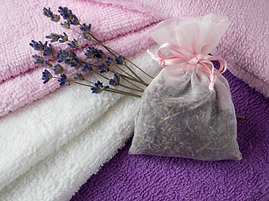
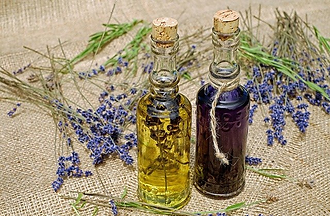
Most essential lavender oils (Etsy) are created industrially through the process of distillation. It takes a huge amount of lavender to produce just a small amount of essential oil.
However, you can make basic lavender oils at home as a hobby.
steeping dry lavender into a carrier oil for one to several weeks. The lavender infuses into the oil which absorbs the natural oils of the lavender. A carrier oil could be extra virgin olive oil, jojoba oil, sweet almond oil or more.
It is suggested to use English lavender to create a more aromatic oil. You must also harvest the lavender at the peak time, right before blooming, to ensure the best aromatic and healing lavender oil. Use only 100% dried lavender buds. Steeping them in the oil while there is still moisture in the buds will cause the oil to grow mold or spoil.
View the video below to learn how to make your own lavender oil, lavender room spray, and skin toner.
Crafting With Lavender
There are countless things to make from lavender. I will only explore 3 crafts; lavender bath salts, lavender yoga mat mist, and massage oil for a good night’s sleep. You will need dry lavender buds for the following projects. Purchase dried lavender buds here. (Etsy)
Lavender Bath Salts Recipe from Garden Therapy
Materials:
-
epsom salts
-
100% pure lavender essential oil (Etsy)
-
dried lavender
-
Mason jar (or any type of jar with lid)
Steps:
-
Open your Mason jar and set the lid aside, but keep it handy.
-
Fill the Mason jar about halfway full of the Epsom salts.
-
Next, add the lavender oil (about 10-15 drops are about right for a medium sized container, less for a smaller container). Replace the lid and shake it well to combine.
-
Remove the lid, and add 1 tablespoon of dried lavender flowers. Then replace the lid once more and shake to combine.
-
Add more Epsom salts to fill the jar and replace the lid and shake until well blended.
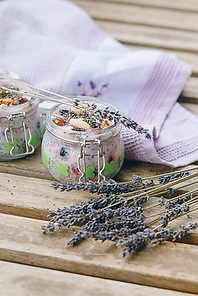
Lavender Yoga Mat Mist from Heavenly Haven
Materials:
-
1 16 oz spray bottle
-
1/4 cup witch hazel
-
10 drops of lavender essential oil
-
10 drops of lemon essential oil
-
5 drops peppermint essential oil
-
3 drops tea tree essential oil
-
Filtered water
Steps:
-
Add witch hazel to the spray bottle and top it with water until almost full.
-
Now, add in essential oils. You may want to add more for a more fragrant spray.
-
Shake and spray directly onto mat.
-
Wipe the mat clean using a towel and leave it out to dry completely.
-
Apply after each yoga mat use or as desired.
Massage Oil by BRIT-CO
Ingredients:
-
1-ounce glass bottle, with tightly fitting lid
-
1 ounce of jojoba oil
-
14 drops of lavender essential oil
-
6 drops of marjoram essential oil
-
2 drops of Roman chamomile essential oil
-
8 drops of ylang ylang essential oil
Steps:
-
Pour one ounce of jojoba seed oil into a one ounce bottle.
-
Add your essential oils and shake vigorously.
-
Let this sit overnight and use it the next time you’re ready to sleep.
-
Dab a little on your temples or massage into the back of your neck and feet.
-
Sleep like a baby in no time.
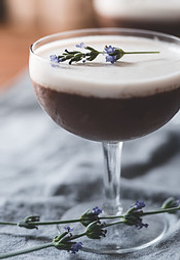
Final Thoughts on Common Uses of Lavender
Lavender is used throughout the world for such things as culinary delights, medicinal uses, room sprays, skin toners, and arts and crafts. This versatile herb has delighted people through the centuries. I hope you will use these tips to make your own lavender creations.
If you enjoyed this article, please share it with others. I’d like to here your thoughts so please comment below.


